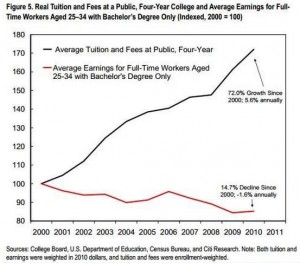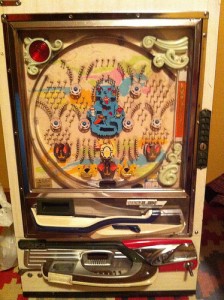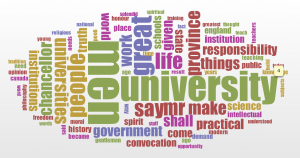Textal is a moble app (for the iPhone) that lets you “explore the words used in your favourite book, document, website, or twitter stream.” It looks beautiful, but I can’t find it on the app store. I like the idea of having something like this for my iPad on which I read more and more.
Clay Shirky: How to Save College
 Clay Shirky has another essay on MOOCs titled, How to Save College. This essay from February 7th is in the Awl. He makes a couple of important points:
Clay Shirky has another essay on MOOCs titled, How to Save College. This essay from February 7th is in the Awl. He makes a couple of important points:
- The cost of college is going up faster than its value (see graph above that originally comes from here). Costs have been going up 5.6% (in the USA) and the earnings of people with just a Bachelors have been going down 1.6% a year. That doesn’t mean you shouldn’t get a Bacherlor’s, and I think the graph is a bit deceptive, but the rise in cost of higher education in the USA is unsustainable.
- “Things that can’t last don’t. This is why MOOCs matter.” While I am not sure MOOCs are the answer, I agree that higher-education can’t continue as is if the costs continue to go up at this rate. Various forms of competition are cropping up and more will.
- Shirky reminds us that for most people college is not the elite residential liberal arts colleges or even the large public universities. It is the commuter colleges teaching 2-year degrees (that people do part-time in many more years.) He could also have pointed out that it is becoming the millions of youth in India and China who can’t get into the coveted university positions, but still want to learn. The elite liberal arts colleges and public universities are not threatened by MOOCs – they will continue to offer an elite education to a minority who can afford the time and money it costs. It is just that cheaper alternatives to college will become how a larger and larger percentage of citizens learn.
- Shirky is particularly critical of the defensiveness of academics in the face of change. For Shirky what we do “is run institutions whose only rationale—whose only excuse for existing—is to make people smarter.” We should be open to new technologies and configurations that can do this better or reach a different audience rather than getting huffy and looking for reasons to dismiss MOOCs.
- Shirky feels academics shouldn’t be trusted “when we claim that there’s something sacred and irreplaceable about what we academics do.” We are inside the existing institutions and are invested in them. There is a danger that we will get more defensive and less willing to experiment as we feel more threatened.
- Shirky also addresses the issue of why all the fuss now when MOOCs and other alternatives have been around for a while. For him it is a matter of perception. Only now are people taking alternatives to the university seriously and that change in perception could lead to all sorts of people trying alternatives.
As I’ve mentioned before, I’m less convinced MOOCs will make such a difference, but do think that rising costs will lead to more and more people trying alternatives (of which MOOCs are only one.) The cost issues is also very different outside of the United States in countries that don’t have super expensive private colleges. In Quebec, for example, tuition is below $3,000 a year. Student protests have made it very difficult for governments to raise tuition. It is hard to imagine students choosing MOOCs that cost almost as much once you add all the course fees. Instead MOOCs will probably just be woven into public university education as a way of cutting costs so you will end up with more or less the same education.
The good news is that there is renewed interest in education which is important to education. Even better is that people still want to learn whether through MOOCs or college or reading books. Even if MOOCs turn out to be no better than reading a how-to book we should still welcome any addition to our collective knowledge and learning opportunities.
Virtual Research Worlds: New Technology in the Humanities – YouTube
The folk at TextGrid have created a neat video about new technology in the humanities, Virtual Research Worlds: New Technology in the Humanities. The video shows the connection between archives and supercomputers (grid computing). At around 2:20 you will see a number of visualizations from Voyant that they have connected into TextGrid. I love the links tools spawning words before a bronze statue. Who is represented by the statue?
Continue reading Virtual Research Worlds: New Technology in the Humanities – YouTube
Antique Pachinko
This weekend I bought the “antique” pachinko machine above. (To learn about pachinko see this clip from a Wim Wenders documentary Tokyo-Ga.) It looks similar to the Monkeys and Elephants Nishijin type B machine from 1976 from this collection on Flickr. My Japanese collaborator Dr. Keiji Amano tells me it was placed in the Gomangoku pachinko parlor in Shizuoka in 1977 based on the license stickers in the lower left of the playing field.
There are a number of great resources on the web for people who like to collect and restore older machines. Here are some that friends have pointed me to:
- Vintage Pachinko is a nice clean site that has lots of information including videos and useful services.
- Dan’s Pachinko Data Page has useful information and videos. The machine on his home page is close to the one I bought.
- Pachinko Planet has historical information, services and again videos. James King has even written a book (available in e-formats) on Pachinko Machine Restoration.
- EBay has a number of vintage machines and parts listed.
- Dr. Amano has put up some scans of a Japanese book on very old machines. See Scrapbook photos.
- PachiTalk.com has a forum for Pachinko and Pachislo and a section with playing manuals (that I haven’t looked at)
A question that people have asked me is how a 1970s pachinko machine ended up in an Edmonton antique mall (which is actually more like a flea market)? James King has a good post, Pachinkos in America: Where Are They? on research he has done using analytics (on Pachinko Planet) which suggests it may be been brought over by a serviceman or by a company that imported used ones to the US. Here is part of what he says,
Japanese pachinko parlors for decades only allowed machines to remain in service for about a year before they had to be removed and disposed. This led to huge numbers of used machines available in Japan, and most were simply destroyed. However, it was not unusual for American servicemen to send or bring them back to the states as souvenirs. The numbers that trickled in spread out from our major military installations, but in the 1950’s and 1960’s these numbers were small, somewhere in the thousands. Few of these pachinkos have survived today.
In the early 1970’s a few enterprising gentlemen got a good idea for a use for all of those piles of expired pachinkos. They formed a company called Target Abroad LTD, and started buying them up by the thousands and filling shipping crates with them. They then shipped these crates by the thousands to America, and sold them through major chain stores such as Woolworth, K-Mart, and even Sears. Several other smaller companies quickly formed and opened pachinko specialty stores across the country. Two of the most successful were Pachinko Palace and The Pachinko Factory, and many vintage pachinkos in America today still bear their stickers. Literally millions were sold between 1972 and 1976, but sales began to plummet when video games were invented and then mass- produced. By 1978 nearly all imports of pachinkos to America had ended, and the retailers sold off their inventory and closed their doors forever.
It is possible that collecting and restoring vintage machines is more popular in the USA than in Japan. Dr. Amano tells me that there is little in Japanese to match the restoration manuals and videos available in English. Pachinko may have a charm for people in North America that it doesn’t have in Japan. To us it is an exotic pinball-like game with lovely designs (especially the vintage ones before they got video screens) from the mysterious orient. For the Japanese it is a reminder of noisy smoky pachinko parlours where older men gamble endlessly alone. Given how little Japanese research there is into pachinko (considering the extraordinary amount of money spent on it) it is likely that to many Japanese it is an embarrassment which they wouldn’t want to collect.
@samplereality and Twitter fiction (?)
A week or so ago I began to follow Mark Sample’s tweets carefully as his tweeted what at first sounded like a nightmare at Dulles when he went to catch a flight. As he tweeted through the days it became more surreal. It seemed he was sequestered and being interrogated. He reported shots and deaths. It was hard to tell what was going on and then it was all over with a link to a YouTube video of him whispering into the phone. Then when you clicked on @samplereality you got “Internal Server Error” and if you tried to find his page you got a “Sorry, that page doesn’t exist!”
Someone had deleted his account.
Fortunately there was an off-site archive of his tweets that he had backed up here. And, as a useful hint, there was an entry on ProfHacker by Sample on how to Keep Your Official Twitter Archive Fresh which the editors introduced with,
this is a draft that Mark Sample uploaded to Profhacker last week. We have been unable to contact Mark for the final revisions, so we are posting it as-is. Our apologies for any errors.
It seemed more and more likely that the dramatic events in Dulles were a work of net fiction or an alternate reality game, something Mark is interested in and claimed to be working on for 2013 in his blog entry From Fish to Print: My 2012 in Review. I was also suspicious that none of his colleagues at George Mason seemed to be that worked up about his experience. And that’s the fun of this sort of alternate reality fiction. You don’t really know if you’re being taken or not and so you start poking around. Like many I was initially sympathetic (who hasn’t been inconvenienced by delays) and then worried. Eventually I decided the stream of posts were a work of fiction, but of course I’m still not sure. When alternate reality fiction is done well you never know whether This Is Not A Game.
I still don’t, but I’ll risk a guess and congratulate Mark … Bravo! If I’m wrong I apologize.
Tory 1908 Address to First Convocation of U of Alberta
Voyant Word Cloud of 1908 Address
Here at the University of Alberta we return for inspiration to the founding President’s words at the 1908 Address to the First Convocation. In particular we have taken to heart Henry Marshall Tory’s words about “uplifting the whole people.” Here is the relevant paragraph,
In many of the older universities men of merit were deprived of the privileges which they offered sometimes by creed or class legislation. The modern state university has sprung from a demand on the part of the people themselves for intellectual recognition, a recognition which only a century ago was denied them. The result is that such institutions must be conducted in such a way as to relate them as closely as possible to the life of the people. The people demand that knowledge shall not alone be the concern of scholars. The uplifting of the whole people shall be its final goal. This should be the concern of all educated men, it be never be forgotten.
The phrase “uplifting of the whole people” has become the promise of the University though I doubt many of us think about it more than casually. In Tory’s address it is connected with nation building and civilization. Every state in the USA has a university, now every province in Canada will get one. The state university has a special responsibility to the people. There is also a strong thread of praire populism to the address. He recognizes that universities have excluded people and been sites of privilege, something to be corrected in the “modern state university” that lists to the demands of the people and relates to them.
Tory touches on a number of other issues in his talk that we should also think through. He talks about the importance of pure intellect to the university. He connects this with “the highest ideals of life.”
[Universities] have arisen as a result of the demand of the intellect pure and simple. Quite apart from practical results, the restless energy of the human mind, slow to accomplish results, but never resting in its efforts, has demanded that a place should be found where men may be given an opportunity to fit themselves by rigid training to solve the problems of life. Thus it has become the task of the university to hold up the highest ideals of life; to help create in the hearts of men and to sustain in them a love for those things which are higher than food and raiment; to emphasize the teaching of the greatest of all teachers that man’s life consisteth not in the abundance of the things which he possesses. It has become a part of their recognized responsibility to instill a love of those things which really constitute greatness; to emphasize the things of the mind above those of the body; in relation national life to place patriotism above party; in our relations to others to place love above hate; in our relation to knowledge to choose truth and not error; in our relations to ourselves to be men not things.
He returns later to these high ideals which turn out to be echoed in the “moral and spiritual sense of the Christian world” which has triumphed over materialism. The university is to be a place that fosters ideals that are consistent with the Christian world and not a “materialistic philosophy.”
Did I say materialism was dead? I say it again! Man knows that he is greater than the clod and in that knowledge lies his supremacy. The age of thought has only begun. In spite of the practical and materialistic philosophy which expresses itself still [in] the commercial spirit of the age I assert the deepest conviction of my being that thought and mind are still supreme. We who teach may be called idealists. Let me say to you that the idealist still lives and lifts his head to the stars and declares the impossible can be accomplished. All the ages of progress have been his ages and when the spirit of a material age is dead and the philosophy of materialism is forgotten the idealist will still be conquering the world.
Tory touches on the importance of faculty and admonishes that faculty not be treated as “state officers.”
The members of the university staff must not be thought of in the ordinary way as state officers. They must rather be regarded in the light of independent thinkers and scholars who are to bring us into that appreciation of those higher things about which I was speaking a moment ago.
He then goes on to talk about teaching and giving faculty the freedom to teach well. He trusts us to handle this freedom with discretion.
Our professors are first of all teachers. To them the largest freedom must be given. It is their duty to push into the heart of things that the truth and nothing but the truth may be, discovered. I am sure they will temper freedom with discretion.
While on the whole the address is remarkably current there are two dated and distasteful aspects. First of all is the sexism of the language that talks only of men and manhood. There is no recognition that women might be part of the whole people. I hear the echo of muscular and rational Christianity in this address. Secondly there is a race consciousness or pride in Alberta’s youth and mingling of peoples that strikes me as vanity.
We are not a degenerate race, we are a race produced by the mingling of the best blood. We are not yet dissolute in temper, but still have the firmness to govern and the grace to obey. We are rich in the inheritance of honour bequeathed to us through a thousand years of noble history and we may make it our daily thirst to increase it with splendid service, so that if it be a sin to covet honour, Canadians should be the most offending souls alive.
International Conference on Japan Game Studies
 I am part of a team putting together a International Conference on Japan Game Studies. We are organizing this with the Prince Takamado Japan Centre at the University of Alberta and the Ritsumeikan Center for Game Studies in Kyoto. The deadline for proposals is in two weeks. We are looking for papers on:
I am part of a team putting together a International Conference on Japan Game Studies. We are organizing this with the Prince Takamado Japan Centre at the University of Alberta and the Ritsumeikan Center for Game Studies in Kyoto. The deadline for proposals is in two weeks. We are looking for papers on:
- Cross cultural study of games and toys
- Localization of games
- Assessment of educational aspects of games
- Preservation of games and game culture
- Understanding player culture
- Game industry (in Japan and transnationally)
- Games and transmedia phenomena
- Games of chance
Literary History, Seen Through Big Data’s Lens
I am seeing more and more articles in the media about text analysis and the digital humanities. Ryan Cordell used the platform of the amazing story of his children getting millions of FaceBook likes to get a puppy to discuss the digital humanities and he studies how ideas could go viral before the internet. (See the CBC Q podcast of his interview.)
From Humanist I found a New York Times article by Steve Lohr on Literary History, Seen Through Big Data’s Lens. The story talks about Matt Jockers’ forthcoming work on Macroanalysis: Digital Methods and Literary History (University of Illinois Press). Matt is quoted saying,
Traditionally, literary history was done by studying a relative handful of texts, … What this technology does is let you see the big picture — the context in which a writer worked — on a scale we’ve never seen before.
In today’s Edmonton Journal I came across a story by Misty Harris on If Romeo and Juliet had cellphones: Study views the mobile revolution through a Shakespearean lens. This story reports on a paper by Barry Wellman that uses Romeo and Juliet as a way to think about how mobile media (text messaging especially) have changed how we interact. In Shakespeare’s time you interacted with others through groups (like your family in Verona). Now individuals can have distributed networks of individual friends that don’t have to go through any gatekeepers.
The Never-Before-Told Story of the World’s First Computer Art
The Atlantic has a story about The Never-Before-Told Story of the World’s First Computer Art (It’s a Sexy Dame). The image (see above) was apparently created by an IBM programmer for the SAGE system and was used as a diagnostic.
According to Tipton, the program that displayed the pin-up image was a diagnostic that tested data flow between the two SAGE computers on site (referred to as the A and B computers). At the end of every shift, as one computer was about to go offline and switch over to the other, the active machine would begin transferring flight and intercept data to the standby machine so there could be a seamless switch over.
Two switching consoles on site were used to handle this process. After running the diagnostic, Tipton describes, if the pin-up displayed correctly on the screen, then data was being transferred between the A and B computers correctly. If the image displayed improperly, then the technicians immediately knew there was a problem.
This reminds me of the story of Lena and the use of her image. Why were so many early images drawn from porn? Does this say something about the male culture of computing in those years that it was cool/acceptable to use pin up pictures when you needed a graphic image?
Thanks to @manovich for this.
The TEI at Work Animation using gource
Martin Holmes uploaded a neat animation of a visualization of The TEI Council at Work that shows version editing of the TEI documents.
The animation is generated by gource – software version control visualization.




